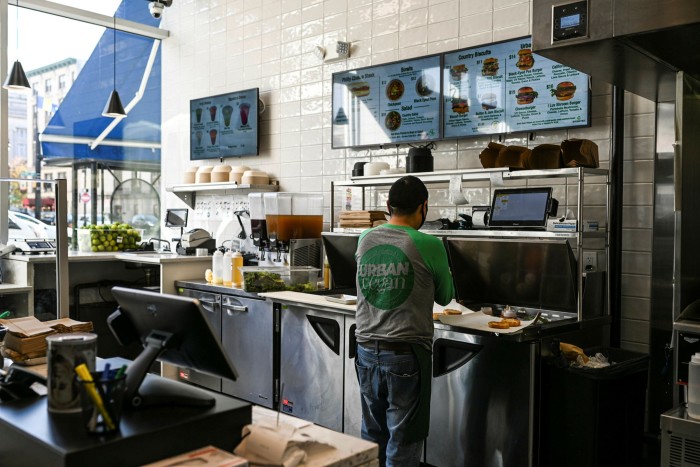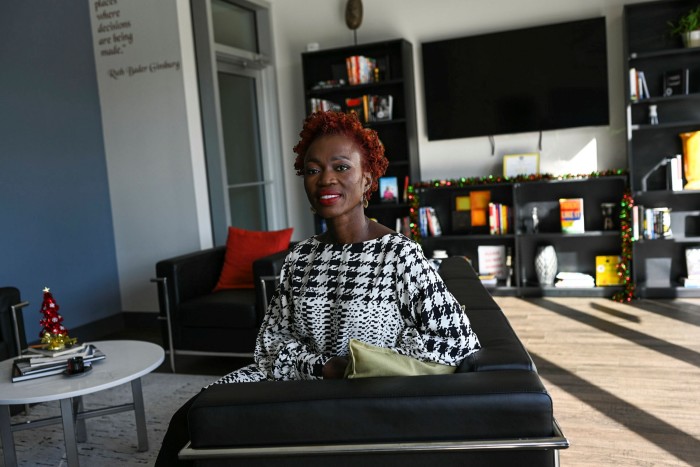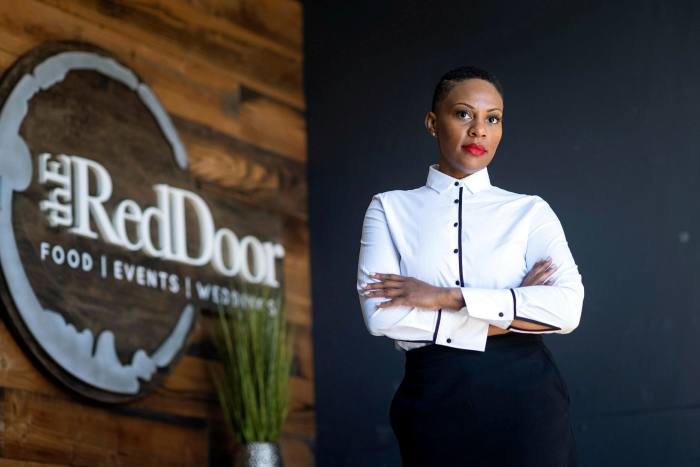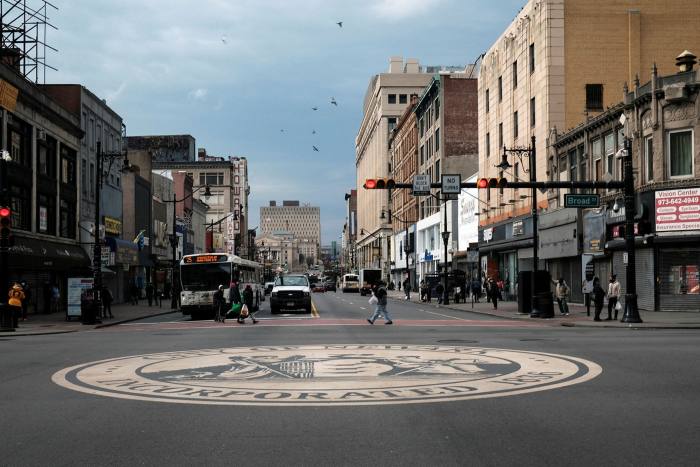This is the first part of a series of articles looking at race and the financial system
The US banking industry has a blind spot. Boasting the best analytical capabilities money can buy and trillions of dollars of liquidity to put to work, the bedrock commercial lenders of the world’s biggest economy still manage to overlook people like Adenah Bayoh.
Bayoh is an African-American entrepreneur, based in Irvington and neighbouring Newark, New Jersey, two mainly black areas just across the Hudson River from New York. She arrived in the US at the age of 13 from war-torn Liberia, and in the three decades since has assembled a property and restaurant portfolio that includes a retail and residential development across the street from Newark City Hall; four International House of Pancakes franchises; two soul food eateries called Cornbread and the first of several planned Urban Vegan outposts. She even serves on an advisory council of the Federal Reserve Bank of New York.
As might be expected, Bayoh struggled to obtain financing at the start. All she had was an idea: that her community in Irvington included enough pancake lovers like herself to support its own IHOP. When she tried to buy an old diner to convert into an outpost of the restaurant chain, she says seven banks turned her down for a loan. She only broke through in 2007 when an IHOP official intervened to help her secure credit from a General Electric lending arm.
FT Series: Race and finance
Features in this series include:
Part 1 – The segregated banking system
Part 2 – The trap of student debt
Part 3 – Fund managers fail to walk the walk
In the years that followed, Bayoh says obtaining bank backing remained “the bane of my existence”. At a time when banks could borrow overnight at nearly zero interest rates and arrange small businesses loans with rates in the mid-single digits, Bayoh regularly paid more for her money as she tapped other lending sources ranging from the public-minded to the predatory. She says her annualised borrowing costs reached as high as 30 per cent when she turned to merchant cash advances — funds provided in return for a share of credit card revenues — to meet emergencies.
Only weeks ago, Bayoh says she ran into a roadblock at a New Jersey bank when she sought help to start a new Urban Vegan. The lender had refinanced the GE loan on her first pancake house on better terms, but told her it wanted a “depository relationship” before it would extend more credit. She told the bank that moving her accounts would be difficult because its closest branch was in a mostly white suburb at least a 20-minute drive from her restaurants. She asked why the lender had no branch in Irvington, and “they said it wasn’t their market”.
“Banks find a way to say no to people like me,” she says. “I really get anxiety whenever I have to go to a bank for lending purposes. They don’t know me. Adenah doesn’t exist to them.”
Bridging the divide with the Bayohs of business has been a priority for banks since the murder of George Floyd last year focused attention on US racial disparities. From Wall Street to the City of London, lenders pledged to provide tens of billions of dollars in credit and other aid to unlock market mechanisms that could help communities of colour.

A year and half later, the banking industry remains part of the problem even as it works on solutions. African-Americans are still struggling to obtain the lower-cost bank credit that would help them build their own businesses and close the US racial wealth gap. The median US white household has $188,200 in wealth, nearly eight times more than the median black household’s $24,100, according to Brookings.
Even successful black Americans are less likely to have a phone number to call or a name to drop at a bank. While 54 per cent of “healthy or stable” white-owned small businesses had borrowed from a bank in the past five years, only 33 per cent of similar black-owned businesses had done so, the Federal Reserve found in its last small business survey before the pandemic. Overall, fewer than one in four of black-owned employer companies had borrowed from a bank, and that figure fell to one in 10 for sole proprietors. Meanwhile, nearly 14 per cent of black households had no bank accounts at all, compared with 2.5 per cent of white households, according to the Federal Deposit Insurance Corporation.
‘Bootstrapping since the day I started’
Black entrepreneurs tend to bank on themselves — even when they have worked in financial services. That was the case when Dawn Kelly, 59, started a juice, smoothie and salad bar called The Nourish Spot four years ago in the Jamaica section of the New York City borough of Queens. Let go by Prudential Financial after 16 years in the insurer’s communications department, Kelly used her severance package to lease and renovate a store. She says she did not ask for a loan since she doubted any bank would back a black woman pursuing her dream.
“I have been bootstrapping my business since the day I started,” she says.

When Covid-19 arrived, the lack of banking relationships hit black-owned businesses hard. To keep small enterprises afloat as the US locked down, the federal government disbursed $525bn in 2020 through the Paycheck Protection Program, using banks as the main intermediaries at the start. Lacking the right connections, businesses in minority areas received a disproportionately small share of the first round of aid.
More money flowed into minority communities later as other lenders joined the effort, but the initial disparity had an impact. Between February and April 2020, 41 per cent of African-American businesses ceased operations, compared with 32 per cent of enterprises owned by Latinos, 26 per cent by Asians and 17 per cent by whites, according to an analysis of federal data by economist Robert Fairlie of the University of California at Santa Cruz.
“The money went directly to financial institutions that were mainstream, and they basically lent it to people they were used to lending money to,” said Ras Baraka, mayor of Newark, New Jersey. “A lot of black and brown companies did not get a chance to get any of that.”
Perversely, one of the reasons minority entrepreneurs have so much trouble borrowing money from banks is that they need so little of it — only tens of thousands of dollars in many cases. Black-owned businesses are generally small: 96 per cent are one-person operations, says the Association for Enterprise Opportunity, and nearly half are beauty salons and barber shops or day-care, home-health and janitorial services.
Black-owned businesses face a more difficult outlook
41%
Share of black-owned businesses that ceased operations at the start of the pandemic, compared with 17% for white-owned firms, according to the Federal Reserve Bank of New York
58%
Proportion of black-owned employer firms that were considered at risk or distressed before the pandemic. For white-owned companies, the figure was 27%
33%
‘Stable or healthy’ black-owned businesses that received funding from banks over the last 5 years. That compares with 54% for white-owned firms
Today’s banks, by contrast, think big. The pursuit of economies of scale has helped reduce the number of US banks from more than 14,000 in the early 1980s to 4,914 this year, the FDIC says. The big banks that dominate the industry are focused on megadeals, mass markets and the ultra-wealthy.
Small fry of any colour are less appetising, since it costs banks roughly as much to process their loan applications as it does for a bigger fish. US bank loans of $1m or less for businesses and commercial real estate fell from $710bn in 2008 to $580bn in 2013 and $640bn in 2019, according to an analysis of FDIC data by Rebel Cole, a Florida Atlantic University professor. He says the decline had “a disparate impact on minority small businesses because they tend to be smaller”. By contrast, similar business bank loans of more than $1m rose from $1.56tn in 2008 to $2.75tn in 2019.
“In our community, we are so scared of debt that we make do with very little and we aren’t really a benefit to a bank,” says Reign Free, the African-American founder of Red Door Catering in Oakland, California, who was turned down by her bank when she sought a loan for her first delivery van. “It was easier to get funded for $250,000 versus $50,000 — that was the struggle.”
Financing small businesses can be tough work for banks. Record-keeping at such enterprises is often lacking. Many avoid reporting income for tax reasons, only to find out later that it would help them obtain credit. What works in one area might not in another, bankers say.

“I don’t think you can just airlift millions of dollars into a community — you have to be on the ground, understand their needs,” says René Jones, the son of a Belgian mother and an African-American father who is chief executive of M&T Bank in Buffalo, New York, which recently pledged $43bn in loans and other support for underserved communities.
“Generations of families have not had the access to capital or home ownership, so they don’t even have the wherewithal to begin. Somehow, the whole thing has to be jump-started in a very different way than before to create access to financing and equity.”
To provide credit to minority communities, banks often work through other intermediaries called community development financial institutions. CDFIs are federally designated private lenders who channel capital to borrowers in low-income areas, while providing financial advice and other assistance in the hope recipients will evolve into bank customers. They have received billions from big banks such as JPMorgan Chase and Bank of America.
The typical CDFI is a loan fund that borrows most of its money from banks, paying interest rates in the low single digits. The rest of their funds come from investors and grants from governments and philanthropies. Banks benefit from lending to CDFIs because it helps them meet their obligations under the Community Reinvestment Act, a federal law aimed at preventing “redlining”, the practice of denying credit to minority areas.
CDFIs usually charge higher interest rates for small business loans than banks because their borrowers are riskier, industry participants say. CDFI interest rates on loans “on average” are 5-12 per cent, with origination fees of 0.3-2.5 per cent, according to the CDFI Fund, an arm of the US Treasury created in 1994 to support such lending.

“The interest we earn off our loans does not pay for our entire operation,” says Ray Waters, president of the Detroit Development Fund, a CDFI. Bank borrowings are usually earmarked to fund loans, he adds, meaning grants from foundations play a critical role in covering staff and technology costs. “It’s like we need technical assistance ourselves.”
CDFIs argue that their rates are far cheaper than the alternatives on which many minority-owned businesses rely. Accion Opportunity Fund, a CDFI based in San Jose, California, says it has refinanced business owners facing annualised borrowing costs up to 358 per cent. NerdWallet, an online finance platform, says annualised borrowing costs for US business lines of credit from $6,000-$250,000 run between 10 and 99 per cent.
Predatory lenders “hover around like vultures”, says Deanna Sison, a Filipina-American co-owner of San Francisco’s Little Skillet and Victory Hall restaurants, who turned to Accion Opportunity Fund for help in refinancing. “They always seem to know when you are struggling.”
![Ras Baraka, mayor of Newark, says money dispersed by the federal government’s Paycheck Protection Program ‘went directly to financial institutions that were mainstream [and] a lot of black and brown companies did not get a chance to get any of that’](https://www.ft.com/__origami/service/image/v2/images/raw/https%3A%2F%2Fd1e00ek4ebabms.cloudfront.net%2Fproduction%2F2284fafd-a930-43d1-ad69-5dda5175a40f.jpg?dpr=1&fit=scale-down&quality=highest&source=next&width=700)
Bayoh credits CDFIs in New Jersey with helping her come back after the 2008 financial crisis. To raise money for the down payment on her first restaurant, she took out subprime mortgages on residential properties and lost several to foreclosure during the downturn. “I had a dark period,” she says, “five, six, seven, eight years of no one saying yes to me.” It was only when she found CDFIs that she began to expand. “When you are dealing with CDFIs, you are dealing with someone who knows you by your name,” she says. “They are in the community doing the same work you are doing.”
The dilemma facing CDFIs is that for the model to succeed, their borrowers need to graduate — to become bank customers. But that is rare, says Luz Urrutia, chief executive of Accion Opportunity Fund. Banks are keen to back CDFIs to obtain CRA credit but hesitate to form relationships with their borrowers, she says. Many of her customers just scrape by. Their median income is $37,000.
“You would be surprised how few customers go from CDFIs to banks — banks don’t touch them,” Urrutia says. “Nothing has changed. If anything, it’s getting worse because the perception is that it’s too hard to serve them. Banks are missing a huge opportunity to have a full, well-rounded relationship with these businesses as they grow and thrive.”
Community lenders are searching for ways to do better. During the pandemic, CDFIs joined in efforts to provide lower-rate loans with help from New York, California, Washington and a coalition of southern states, raising hopes of creating new approaches to bring down borrowing costs.

A capital markets solution?
Another possibility is finding money for minority businesses in the capital markets. Beth Bafford, vice-president of strategy at Calvert Impact Capital, which worked on the state financing structures, says more standardised data on CDFI loan performance is needed before the assets can be used to back securities. She says an effort by President Joe Biden’s administration to invest $10bn in state and local financing programmes for small businesses could help make investors more comfortable in the interim until the real risk is known.
“We don’t know the actual risk of these loans, but we hypothesise that it is much lower than you think it is,” she says. “We are going to use a source of subsidy to prove out the case, so 10 years from now we can price that more efficiently.”
If Bafford is right, the data will tell a similar story to the one Bayoh does today. There is more to her than numbers on a loan application; before she became an entrepreneur, she had endured life in a refugee camp, folded clothes in a laundry, worked as a bank teller, sold bridal gowns, fallen down and gotten back up. “I have had life experiences,” she says. If bankers look closely, they will see “someone who has survived and has grit”.
Additional reporting by Taylor Nicole Rogers in New York

